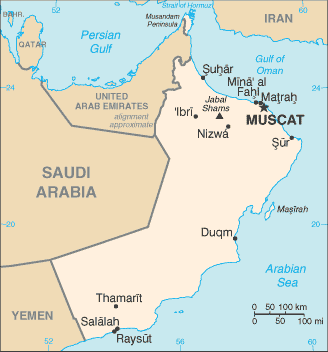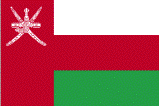|
|
Population: 4,974,986
Brief History of Oman:
Oman became an Islamic country early in its history in the 7th century. For most of Oman's history it has remained an independent country. There was a brief time when Persia conquered portions of the country as well as a time when the Portuguese set up fortifications along Oman's coast.In the 1650's Oman managed to remove the Portuguese from their country. The Sultan of Oman expanded his empire into the east coast of Africa and the southern Arabian Peninsula. In the early 1800s, Oman became the most powerful country in Arabia. Oman also became strong allies with Britain during this time.
In 1970, Qaboos bin Said Al-Said became sultan of Oman and has ruled ever since. He has opened country more to the outside world and trade. Oman tries to maintain good relationships with all the other Middle Eastern countries.

The Geography of Oman
Total Size: 212,460 square kmSize Comparison: slightly smaller than Kansas
Geographical Coordinates: 21 00 N, 57 00 E
World Region or Continent: Middle East
General Terrain: central desert plain, rugged mountains in north and south
Geographical Low Point: Arabian Sea 0 m
Geographical High Point: Jabal Shams 2,980 m
Climate: dry desert; hot, humid along coast; hot, dry interior; strong southwest summer monsoon (May to September) in far south
Major cities: MUSCAT (capital) 634,000 (2009)
The People of Oman
Type of Government: monarchyLanguages Spoken: Arabic (official), English, Baluchi, Urdu, Indian dialects
Independence: 1650 (expulsion of the Portuguese)
National Holiday: Birthday of Sultan QABOOS, 18 November (1940)
Nationality: Omani(s)
Religions: Ibadhi Muslim 75%, Sunni Muslim, Shi'a Muslim, Hindu
National Symbol: Khanjar dagger superimposed on two crossed swords
National Anthem or Song: Nashid as-Salaam as-Sultani (The Sultan's Anthem)
Economy of Oman
Major Industries: crude oil production and refining, natural and liquefied natural gas (LNG) production; construction, cement, copper, steel, chemicals, optic fiberAgricultural Products: dates, limes, bananas, alfalfa, vegetables; camels, cattle; fish
Natural Resources: petroleum, copper, asbestos, some marble, limestone, chromium, gypsum, natural gas
Major Exports: petroleum, reexports, fish, metals, textiles
Major Imports: machinery and transport equipment, manufactured goods, food, livestock, lubricants
Currency: Omani rial (OMR)
National GDP: $85,000,000,000
** Source for population (2012 est.) and GDP (2011 est.) is CIA World Factbook.
Back to Geography Home Page



